STEM is an acronym mostly used in the field of education to group together science, technology, engineering, and mathematics.
STEM education, therefore, combines these four disciplines through an integrated approach, one that offers hands-on experience with relevant and real-world examples. The campaign for STEM education to start at a lower level has been there for quite a while now, and many people are all for that idea.
STEM students not only get to benefit from learning all four disciplines as one, but they also gain problem-solving and critical thinking skills that go hand-in-hand with those subjects. In addition, today’s job market is leaning more and more towards graduates with proficiency in STEM skills.
Table of Contents
What Is A Stem Course?
To put it simply, a STEM course puts a lot of emphasis on the aforementioned disciplines through a hands-on mode of learning and projects that mirror real-world encounters. They are aimed at preparing students for the job market, particularly in the engineering and technology industries.
Why Is STEM Important?
The world as we know it is changing, and as the days go by, more technological advances are being made, with the most notable one being Artificial Intelligence. As it continues to develop, some jobs done by human beings will start disappearing because it will be cheaper and more efficient for organizations to invest in Artificial Intelligence.
It is not all doom and gloom because when one door closes, another one opens.
These technological advances are set to change the skill set that employers need.
It is predicted that most jobs will require a mastery of the exact disciplines that STEM covers. This is why there is a lot of emphasis on ensuring that more students take up STEM courses and that they can adapt to the changing world because one thing that is for sure is that change is inevitable.
Recruitment of STEM Teachers

It is now becoming critical that more students take on STEM programs. This is not only for their own career benefit but also for the entire nation and its economy. We don’t want a situation whereby there are plenty of jobs in the industry but not enough qualified personnel to take them on.
This has pushed the Department of Education to encourage schools to establish STEM departments with qualified STEM teachers and encourage students to take on these courses. As a result, a good number of teachers have shifted from their conventional teaching subjects to help cover the STEM teacher shortage.
For more recourses, check out our article, 50+ Free Educational Apps & Online Resources for Kids.
If you suddenly found yourself teaching STEM-related courses, first of all, congratulations because you are going to trailblaze a generation of engineers and technology experts. This is an opportunity to be at the forefront of something that could potentially shake up the job market in the years to come.
If you’re confused and have no idea where to start, don’t worry because we’ve got you covered. Below are some tips that should be of good help to anyone who suddenly finds themselves teaching a STEM-related course.
Tips for STEM Teachers

While there may not be an exact formula for adjusting to becoming a STEM teacher, there are a few things that can help you out. Here are some of those tips.
1. Integrate All Four STEM Subjects
As stated earlier, STEM combines four subjects: Science, Technology, Engineering, and Mathematics. As a new STEM teacher, you should familiarize yourself with all these subjects and be ready to integrate them into your teaching methods.
As a result, the students will get real-world, meaningful learning. They should receive a more authentic understanding of grade-level science and math content while still in the traditional classes before getting to the practical bit of it.
As a STEM educator, you should help your students apply what they learn at the classroom level to real-life situations. You can do that by setting up practical lessons where their knowledge is put to the test, and they have to use it to solve real-life problems.
This should help them develop thinking, investigative, reasoning, and creative skills that should come in handy in this modern and technology-oriented world.
2. Have a Good STEM Curriculum
It can be relatively hard to find a STEM curriculum that has been set out by the relevant educational authorities, particularly because it doesn’t exist. However, several sites have put up agood and reliable STEM lesson guides.
One of the most popular and highly recommended ones is eFGI for Teachers. Here, you will find a variety of tools to boost your students’ math and science skills, as well as ideas on how to enliven the classroom with engineering projects.
They have lesson plans, class activities, outreach programs, and also web resources, among a host of other things that could guide you to make your STEM lessons as interactive and educative as possible.
Another site that offers good and reliable lesson guides is TeachEngineering. However, you must be cautious in the STEM teaching guides you use because not every guide that claims to be a STEM guide is actually a STEM guide.
Here are a few things you can use to determine if the guide is suited for STEM lessons.
A good STEM lesson:
- Is guided by the seven-step engineering design process in solving problems
- Focuses on real-world problems
- Provides for multiple right answers and reiterates the importance of failure as a part of learning
- Involves students in productive teamwork
- Applies rigorous math and science content in the students’ learning
- Immerses students in hands-on inquiry and open-ended exploration
- Supports a teaching process that is mainly student-centered and inquiry-based
- Requires students to tap into their design skills and create a prototype of the solutions
Using this checklist, you can now know which online teaching curriculum is good enough for you to use and can include in your STEM teacher preparation.
3. Be Ready to Use the Engineering Design Process (EDP)

As you may have seen in the above checklist, the Engineering Design Process (EDP) is an essential part of any STEM curriculum. This is because Engineering is right at the core of the STEM process, and therefore any STEM teacher should familiarize themselves with this process.
The EDP provides students with an avenue to think systematically when trying to solve problems. The process is a seven-step process where the students must define problems, conduct research, develop multiple ideas for solutions, develop and create a device or prototype, and then test, evaluate, and redesign.
Don’t feel any pressure to follow all the steps in sequence as engineers are flexible and can move back and forth between them.
We also have an article dedicated to engineering you should check out. What is the Engineering Design Process? [Plus, a Free Worksheet].
4. Focus on Real-World Problems
One of the main objectives of STEM programs is to prepare students and put them in a position to tackle challenges faced in the real world. During STEM lessons, students address some of the social, economic, health, environmental, and other global problems of the 21st century.
Therefore, as a STEM teacher, you should engrave this in their minds as early as possible. Try to pick out specific problems that they can work to solve. Such problems include global warming, endangered species, environmental health, and even air and water pollution.
A great place to start for environmental awareness is diveable. They have a great article about environmental sustainability.
5. Build Successful Student Teams

In the outside world, or when your students graduate and secure employment, there’s a good chance that they will be required to work in teams for the rest of their careers.
Most STEM-related jobs require the ability to work together towards achieving a particular goal. For this reason, STEM teachers need to instill this quality in students as early as possible.
As a teacher, you should know that organizing students to work together as a productive unit will always be a daunting task.
More often than not, they are usually from different backgrounds and therefore relate to different things. This makes it difficult for them to work together and, at times, can even cause friction.
It is your responsibility to make them be able to work past their differences and co-operate to be in the best position to achieve their goals.
6. How Will Your Students Know They Are Successful?
As you plan out your criteria for STEM activities and lessons, your students will be taking part in design and construction to solve the problem in front of them.
It’s important to remind them that success isn’t always getting an answer right. Failure is a major part of STEM and should be accepted as part of the STEM process.
The focus of solving problems and success is how the student approached the problem and analyzed and redesigned to find the student’s solution.
Let your students know that failure is part of the STEM process.
7. Focus on Student-Centered Teaching
Learning in STEM lessons is often open-ended. Some of the work students are supposed to engage in is hands-on and collaborative, and the decisions concerning solutions should come from the students themselves.
As their teacher, you should allow them room to imagine, and come up with their own ideas, test them to see if they work and let them realize that it may not work. This pushes them to do better and correct their own mistakes. Trial and error is one of the most effective ways for kids to learn; always remember that.
To sum it up, it isn’t easy switching from one discipline to another, especially when your next destination is STEM. It takes some adjusting, and it is quite understandable when you fail to get up and running straight from the offset. Hopefully, the tips above will prove effective in helping you adjust quicker.
If you’re looking for more recourses, make sure to check out our article for kids, 11 Best STEM Picture Books to Inspire Future Inventors, Scientists & Engineers.








